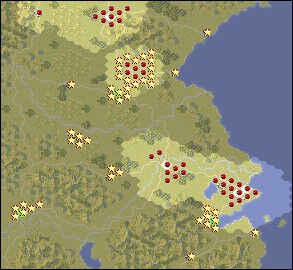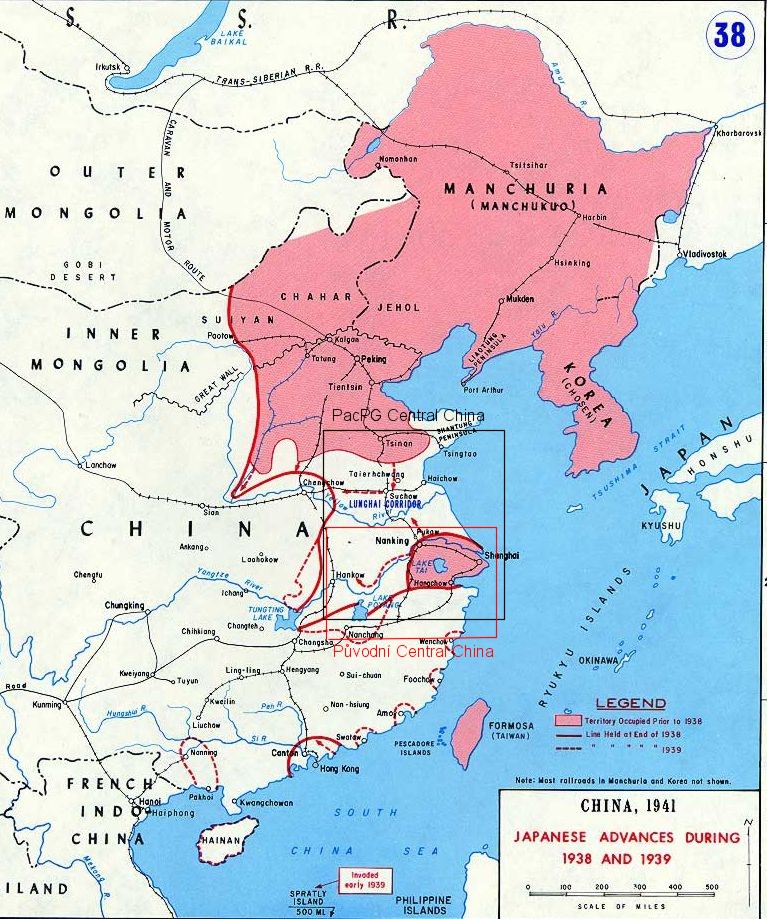 When you move the mouse pointer over the map, unit name, strength and coordinates are displayed as a label. When you press terrain button object name is displayed (city, river, sea, ...) |
Central China
1.2.1938 - 25.10.1938
PacPG: 1.4.1938 - 18.9.1938
Scenario Map:
|
|
|
Changes and corrections of map:
|
Scenario author: Scenario origin: Last revision date: |
stanny 22.12.2005 13.7.2006 |
First release: Revision released: |
4.8.2009 ( Release 01 ) 1.11.2009 ( Release 01 Revision 01 ) |
| The original PacG scenario map was more or less okay, but deployment of units has been completely misguided. Due to better continuity with scenario North China was extended further to the north. Compared PacG scenario map Central China was still one change - in 1938 Kuonmintang relocated flow of the Yellow River, which was reflected in this map. |
Original map:
|
|
|
Historic overview:
| In the first week of April 1938, the Chinese have achieved significant success in the battle of Tai-er-Zhang. Japan 10th Division was surrounded, 5th Division, armed with tanks and heavy guns, had rushed to help, but to no avail. The failure of the Japanese - had 6,000 dead and 30,000 wounded - was significant. However Kuomintang command failed to take advantage of this victory. Japan finally hit the new focus on 200 000 men and 19 May 1938 Suzhou fell. (Aleš Skřivan - Japonská válka 1931-1945, Libri 1997) Article on Czech Wikipedia Article on English Wikipedia
| |||||||||||||||||||||||||||||||||||||
Game play matters:
| Campaign play: Any result leads to scenario Nomonhan. Due to technical reasons we had to set up termination date to September 18, 1938, though fighting continued until the end of October. |
Scenario data:
|
Map size: 37 x 33 hexes 18 turns, 10 days per turn Version: PacPG 1, Starting side: Axis, Campaign: Japanese campaign, Order in campaign: 3. |
||||||||
|
||||||||
|
||||||||
|
||||||||
|
||||||||
|
Game time costingness of scenario: 20.37 % (product of units and turns numbers divided by difference between the most long and the most short scenario) |
||||||||
|
Number of Axis units: 48 units, from them are 11 core units and 37 auxiliary units 9 air units, 0 naval units and 39 ground units 0 of units are loaded to air transport and 0 to naval transport |
Transports Air/Naval: Axis - Allies 1/1 - 0/0 |
|||||||
|
Number of Allied units: 57 units 11 air units, 0 naval units and 46 ground units 0 of units are loaded to air transport and 0 to naval transport |
Initial prestige + every turn donation: Axis / Allies 450 + 0 / 320 + 60 |
|||||||
|
Max number of Axis units: 52 units, from them are 11 core units and 41 auxiliary units - on start of scenario is possible to purchase 4 unit (0 core + 4 auxiliary) |
||||||||
|
Max number of Allied units: 60 units - on start of scenario is possible to purchase 3 unit |
||||||||
Transport units:
|
||||||||
|
The same time period scenarios:
| Central China (PacPG 1) |
| Airfield Anyang East China Sea Fou-Yang Haichow Haichow Wan Hangchow Hangchow Wan Hankow Hefei Display all mapnames in list... |
Tactical map (large & detail):

|
|
|
|
Basic map |
|
|
Map with unloaded transports and order numbers of units |
Battlefield map:

|
|